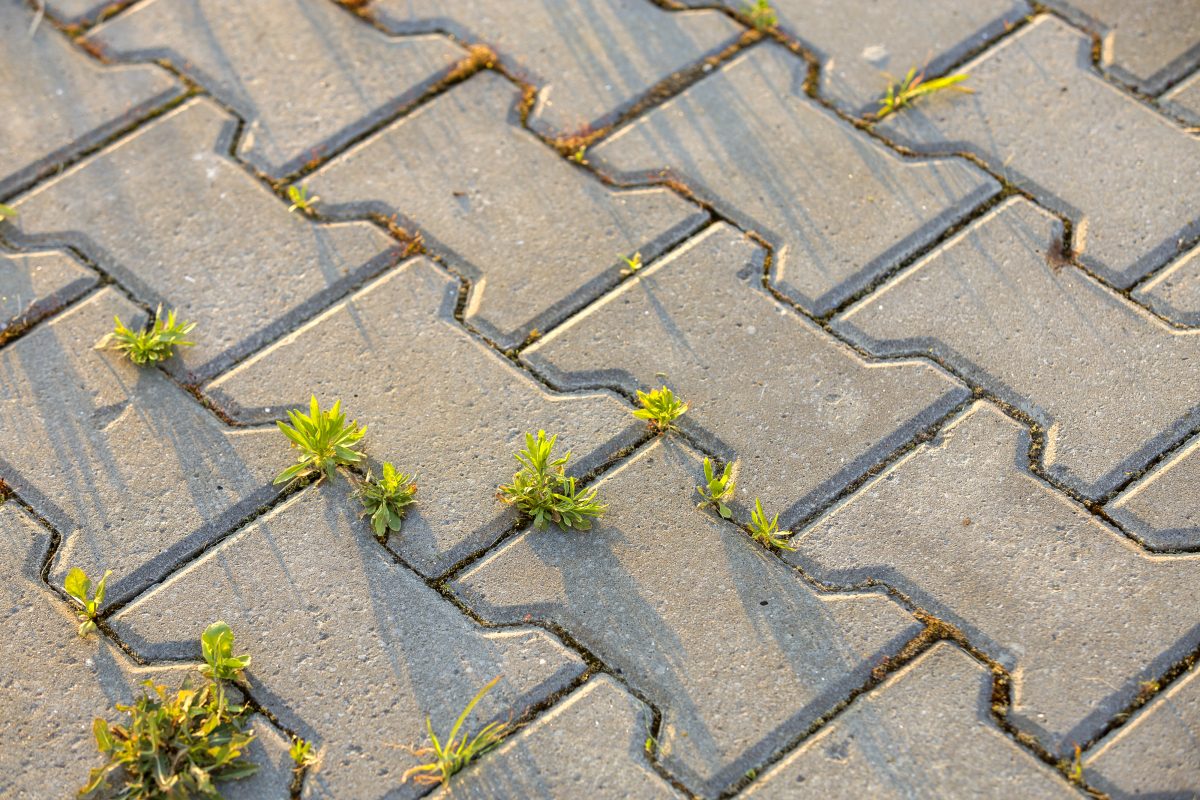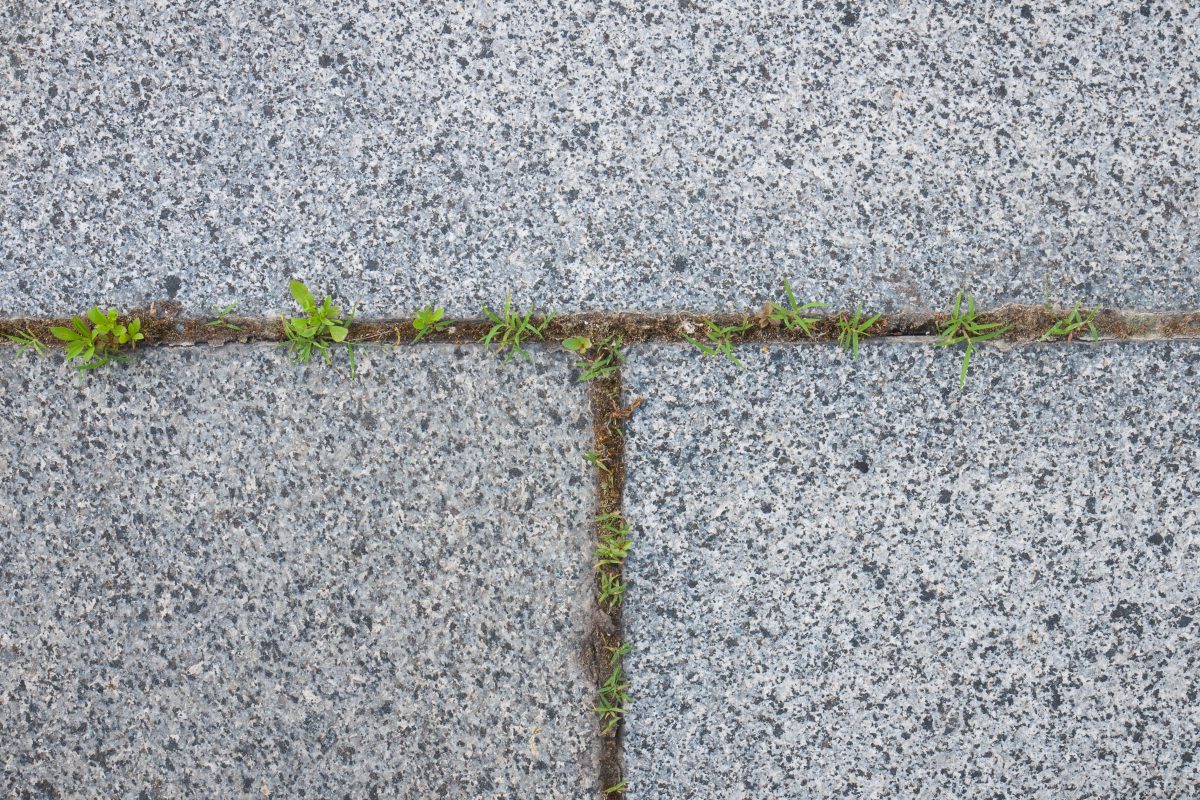
Understanding the Problem: Weeds Between Interlocking Bricks
Let’s face it, weeds between interlocking bricks can be a real pain. They’re unsightly and stubborn, disrupting the uniformity of our beautifully laid paths and patios. But why are they so persistent?
Interlocking bricks, with their tight configuration, seem like an unlikely place for plants to thrive. Yet, these crevices provide just enough space for weed seeds to take root.
Weeds are opportunistic; they’ll grow wherever there’s even a hint of soil or moisture. That includes the tiny cracks between your interlocking bricks where dirt accumulates over time – making them prime real estate for weeds!
Here’s another kicker – some types of weed seeds can remain dormant in soil for years until conditions become suitable again.
- Dandelions? Their seeds may last up to 5 years.
- Purslane? Try 40 years!
- Some clover species? A whopping 80-year lifespan!
Isn’t that something else?
The durability of these pesky intruders is impressive indeed but also makes getting rid of them quite challenging.
Now you might wonder how these pesky invaders find their way into your brickwork in the first place. Well, wind plays a significant role here by blowing weed seeds far and wide – including onto your beautiful brick pathways! Birds too contribute to this by dropping seed-laden waste from above (not exactly what we’d want as souvenirs!).
I’ve got one more thing on my mind – when left unchecked, matured weeds produce thousands upon thousands more viable seeds ready to spread across your property at any given chance!
| Weed Type | Seed Lifespan |
|---|---|
| Dandelion | Up To 5 Years |
| Purslane | Up To 40 Years |
| Clover Species | Up To 80 Years |
So yes, tackling this issue requires understanding its causes deeply while adopting appropriate strategies consistently over time – which I’m confident we’ll do together through this guide! Let’s get those unwanted guests off our property once and for all.
Effective Techniques for Weed Removal
Let’s face it, nobody enjoys the sight of weeds sprouting between their beautifully laid interlocking bricks. It not only tarnishes your curb appeal but can also cause damage over time. Luckily, I’ve got some tried-and-true techniques to help you banish these unwanted guests.
Pour boiling water directly onto the weeds is an effective and eco-friendly method that works wonders. The high temperature causes instant damage to the weed structure, leading them to wither away in no time at all.
Another solution? Use a vinegar-based weed killer! Standard household vinegar typically contains 5% acetic acid which can effectively eliminate young weeds. For older or larger infestations though, you might need something stronger like horticultural vinegar which contains up to 20% acetic acid.
- Pulling out by hand
- Using a weeding tool
- Employing chemical herbicides
Safety first! Always wear gloves and eye protection when dealing with chemicals!
A less conventional but surprisingly successful technique involves using salt or baking soda, both readily available kitchen items that most of us have on hand. These act as natural desiccants drying out the unwanted plants – just be careful not too apply too much as they can affect soil quality adversely if used excessively.
If none of these methods seem appealing or feasible for your situation, consider enlisting professional help who may utilize specialized tools and solutions ensuring efficient removal without causing any harm to your beautiful interlocking brickwork.
Remember: Persistence is key in this battle against pesky plant invaders!
Preventive Measures to Keep Weeds at Bay
Let’s dive into some preventive measures you can take to keep those pesky weeds from sprouting between your interlocking bricks. A little bit of prevention can save you a lot of hard work in the long run.
Firstly, seal the joints. You’ve probably noticed that weeds love to grow in the spaces between bricks. By sealing these spaces, we’re taking away their favorite place to set up shop! Use polymeric sand for this task – it’s specially designed for filling gaps between pavers and will create a strong bond when wetted down.
Next on our list is using herbicides. Pre-emergent herbicides are an excellent choice as they prevent weed seeds from germinating in the first place. Apply this type of herbicide early in spring before weed seeds have had a chance to sprout.
Then there’s landscape fabric – it’s not just great for preventing soil erosion but also acts as a fantastic barrier against weeds growing through your brickwork!
Here are few additional tips:
- Regular maintenance: Don’t let those tiny seedlings become full-blown weeds.
- Using salt: It dehydrates plants and prevents them from absorbing water.
- Vinegar solution: Another natural way; spray directly onto leaves but be careful around desirable plants!
Preventing weed growth isn’t just about keeping your yard looking tidy – it also helps protect your interlocking bricks over time by preventing root penetration which can lead to instability and damage.
Remember, consistency is key here folks! These methods aren’t one-and-done solutions; they require regular application throughout each growing season if you want lasting results!
Keep these preventative measures handy – nobody likes dealing with stubborn garden invaders after all! But remember too much vinegar or salt could harm other parts of your garden so use sparingly!
Conclusion: Maintaining a Weed-Free Brick Pathway
I’ve walked you through the steps of how to get rid of weeds between interlocking bricks, but that’s just part of the journey. Keeping your brick pathway weed-free is equally important.
Firstly, regular maintenance can’t be overstated. It’s like brushing your teeth; doing it daily prevents bigger problems down the road. Here are a few tips:
- Sweep off debris regularly – This helps prevent seeds from settling into cracks and germinating.
- Apply polymeric sand – Acting as a sealant, it fills gaps and deters weed growth.
- Use commercial preventatives – Certain products hinder weed seed germination.
Secondly, don’t let weeds take root in the first place. Once they do, they’re harder to remove without damaging your beautiful brickwork.
Lastly but not least importantly I’d suggest using natural solutions when possible. Chemical herbicides might seem effective at first glance but think about their environmental impact too!
Sure thing- having an interlocking brick pathway adds charm to any home’s exterior aesthetic! Yet maintaining its pristine condition requires some effort on our part too! So here’s hoping my guide has given you insights on keeping those pesky weeds at bay permanently!
Troy Channer is a seasoned professional with over a decade of experience in the construction industry, specializing in residential projects and road infrastructure networks. His expertise spans a broad range of skills, including proficiency in Microsoft Excel, Word, and PowerPoint, which he adeptly uses to streamline operations and enhance productivity.
Troy’s commitment to excellent customer service is a cornerstone of his professional philosophy, always prioritizing client satisfaction and fostering strong relationships. His leadership skills are well-recognized, and he has a proven track record of managing teams to deliver high-quality results.
In addition to his construction experience, Troy is also the proud owner of a successful landscape company based in Oakville. This venture allows him to apply his extensive knowledge of civil engineering and project management to create beautiful and sustainable outdoor spaces for his clients.
Troy holds an Advanced Diploma in Civil Engineering Technology from Humber College, further solidifying his credentials as a highly skilled operations professional in the industry. His combined experience and education make him a versatile professional capable of tackling a wide range of projects.









